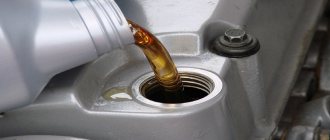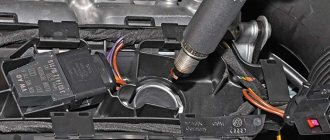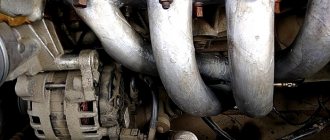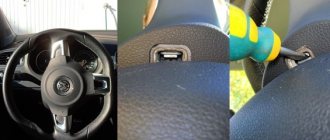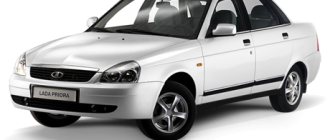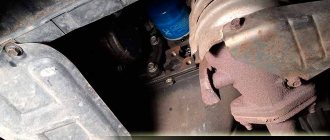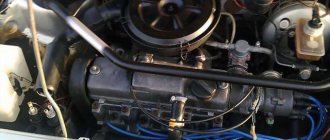Volkswagen Polo Sedan is one of the most popular cars on the Russian market, along with Hyundai Solaris. The car, presented in 2022, is still in demand - largely due to its good driving characteristics, high-quality components and high reliability. In addition, in the case of the VW Polo, some repair work can be done independently - for example, pouring new oil into the engine. Naturally, before this you need to select the oil, and in order not to make a mistake in choosing, you should proceed from the parameters specified in the user manual. So, in this article we will look at how to choose the right oil and how much to fill depending on the displacement of the Volkswagen Polo Sedan engine.
When to change the oil?
For all types of Volkswagen Polo engines, in the service documentation, the manufacturer indicates an oil change interval of 15 thousand kilometers or once a year. But if the car often drives through city traffic jams and sits idle, the lubricant ages faster. Therefore, many owners change the fluid a little more often, once every 10 thousand km. This interval will increase the life of the engine. When purchasing a used car, there is no need to delay changing the oil, even if the date indicated in the service book has not yet arrived.
Amount of oils and fluids volkswagen polo | car breakdowns
Volkswagen Polo is a legendary car. For forty years, five generations of the brand have been delighting its owners with reliable and high-quality service, making life more comfortable and beautiful. But this merit is not only of the manufacturer; the role of the drivers is also great. They carry out maintenance in a timely manner, which has a positive effect on its performance.
Replacing consumables
During the operation of the machine, consumables age and lose their properties, so they need to be replaced. For Volkswagen Polo, the manufacturer recommends that it be carried out once a year or when the mileage is 15 thousand km.
In practice, these periods can be reduced to 10 thousand km. Especially in cases where the car is often stuck in traffic jams and idling. Since the lubricant quickly becomes unusable.
Experts recommend
Below is a table containing all the information that relates to this issue. It specifies parts, systems, quantities and features of consumables.
| Filling/lubrication point | Filling volume, liters | Name of oil/liquid | |||
| Fuel tank | 55 | AI-92 AI-95 | |||
| Engine | Volume 1.6 l | 105 hp | 3,6 | API SL (ILSAC GF-III) VW 502 000 | |
| 86 hp | 4 | ||||
| 110 hp | 3,6 | ||||
| Volume 1.4 l | 3,2 | SAE10W-30 Low temperature areas: SAE 5W-30 | |||
| Cooling system | 5,9 | Antifreeze G12 (G12 G12) with distilled water | |||
| Transmission | Automatic transmission | 7 | Gearbox VW TL 162 | ||
| Manual transmission | Engine 1.6 l | 2,1 | Gearbox VW TL 501 50 (GL-4), SAE75W-85 | ||
| Engine 1.4 l | 1,8 | SAE 80W at low temperatures SAE 75W | |||
| Brake system | 0,5 | DOT 3 or DOT 4 | |||
| Power steering fluid | 1,1 | DEXRON II-D or DEXRON III | |||
PS: Dear car enthusiasts, if you have your own information on this topic, please tell us about it in the comments or write an email to the site administration.
What should be the viscosity of engine oil according to SAE for VW Polo?
Most often, all-season lubricants with the required characteristics are used. All-season has a double number separated by the English letter “W”, which means the word Winter, “Winter”. The first value indicates what low temperature range the lubricant has, and the second indicates the viscosity at high temperatures. As for low temperatures, the indicators are as follows:
- 0W - designed to operate at ambient temperatures down to -35˚С;
- 10W - allows operation at temperatures down to -25˚С;
- 5W - designed to operate at temperatures down to -30˚С;
- 15W - allows operation at temperatures down to -20˚С;
- 20 W - designed to operate at temperatures down to -15.
As for the second indicator, it is not easy to describe it, since it represents a certain collective value of the minimum and maximum viscosity. Operating temperatures are assumed to be 100 and 150. The higher the indicator, the higher the viscosity value at high temperatures of the engine oil. Based on the above, it should be borne in mind that the Volkswagen Polo sedan oil change should be carried out with fluids that have the following viscosity according to the SAE standard:
- 5W-30;
- 5W-40.
Which engine oil is best for Volkswagen Polo sedan 1 6 105 l with
Every car enthusiast knows that the life of the engine depends on the quality of the oil. If you monitor the level and make timely replacements, major repairs may not be needed soon. Using fakes will definitely lead you to a gas station; repairs will be expensive.
Factory recommendations
Fill with the recommended brand of oil.
The manufacturer recommends filling Volkswagen engines with fully synthetic German-made Castrol Edge 5W-40 oil.
For Volkswagen Polo, you can use products from different manufacturers that are suitable for this article. Castrol 5W-40 oil is filled from the factory. Its high-quality composition is preserved in cold temperatures of 30 degrees, and a serviceable engine will start without problems. The product satisfies its qualities and provides an oil film under any load.
Let's look at viscosity and oil manufacturers in more detail below.
Practical subtleties
The selection of oil begins with determining the required viscosity, which is prescribed on absolutely all containers with products.
Before choosing an oil, you need to understand the nomenclature. The designation on the package includes letters and numbers, for example - 5w / 40. The first letter and number is cold viscosity. They show at what negative temperature the oil will lose its properties:
- -35º — 0 W;
- -25º — 10 W;
- -30º — 5 W;
- -20º – 15 W;
- -15º – 20 W.
The second number indicates the consistency when heated. The higher the number, the better the viscosity. These designations apply to SAE rated oil, which is common and can be found in most vehicles.
The Volkswagen Polo Sedan operating booklet contains recommended oil specification tolerances.
The second important criterion is oil resistance. It is indicated by an alphanumeric article and is assigned to brands after studying their composition. With its help, you can select a product for a specific model, taking into account the characteristics of the engine.
What oil is recommended by the factory for constant use?
VOLKSWAGEN Special Plus 5W-40 is an original synthetic recommended by official dealers.
Note: on the original packaging, the meter code is printed by a printer, unlike the fake, where it is convex.
When choosing, you need to pay attention to the manufacturer’s recommended labeling and article number. This oil is indicated in the instructions for scheduled replacement and is poured into the engines of cars that come off the production line.
An oil with the following characteristics is suitable for Volkswagen Polo:
- SAE 5W/30 or 5W/40;
- vW article 502.00, but for Russia 504.00 is recommended.
Tolerance 504.00
Motor oil that meets tolerance 504.00 has better cleaning properties, is less susceptible to oxidation and more effectively prevents the formation of various deposits.
The manufacturer recommends using oil with 504.00 approval for Russia, and here's why:
- does not lose its properties longer during long periods of downtime in traffic jams;
- does not oxidize over time and forms less deposits;
- does not clog oil channels and is easily removed when washed.
The range with this tolerance is up to 15,000 km. This was done in the interests of nature, but without taking into account the resource of the engine (editorial opinion). We have already written in detail about resetting the service interval.
Replacement intervals
The oil change interval depends on the operating mode of the vehicle.
This oil needs to be changed on time, the frequency is standard.
- Average mileage is 10-15 thousand km, suitable for mixed cycle work.
- When driving in city mode, it is recommended to reduce this interval by half and do not forget to check the lubricant level on the dipstick.
CFNA motor problems
The main problem with the CFNA 1.6 is knocking when cold . At first, the knock of the pistons on the cylinder walls manifests itself as a slight tinkling sound in the first minutes after a cold start. As it warms up, the piston expands, pressing against the cylinder walls, so the knocking noise disappears until the next cold start.
At first, the owner may not attach any importance to this, but the knocking progresses and soon even the inattentive car owner realizes that there is something wrong with the engine. The very appearance of a knock (impact of the piston on the cylinder wall) indicates the beginning of the active phase of engine destruction. With the arrival of summer, the knocking may subside, but with the first frost, CFNA will begin to knock again.
Gradually, the CFNA engine knocking “when cold” increases its duration, and one day, it remains even after the engine has warmed up.
Engine knock
The knock of the engine piston on the cylinder wall occurs when the pistons are repositioned at top dead center. This becomes possible as a result of wear of the pistons and cylinder walls. The graphite coating of the skirts quickly wears down to the piston metal
Significant wear occurs in places where the piston rubs against the cylinder walls.
Then the metal of the piston begins to hit the cylinder wall and then scuffing occurs on the piston skirt
... and on the cylinder wall
Despite the large number of complaints, the Volkswagen concern never announced a recall of the CFNA engine Instead of replacing the entire unit, the manufacturer repairs the piston group , and even then only in case of a warranty claim.
The Volkswagen group does not disclose the results of its research, but from the meager explanations it follows that the cause of the defect allegedly lies in the poor design of the pistons . In case of a warranty claim, service centers replace standard EM pistons with modified ET ones, which supposedly should completely solve the problem of pistons knocking in the cylinders .
But as practice shows, overhaul of the CFNA engine is not the final solution to the problem , and half of the owners again complain about the appearance of engine knocking, after several thousand km. mileage The other half of those who have encountered knocking from this engine try to sell the car as quickly as possible after major repairs.
There is a version that the real reason for the rapid wear of the CFNA engine may be chronic oil starvation caused by low oil pressure. The oil pump does not provide sufficient pressure when the engine is running at idle speed, so the engine is regularly in oil starvation mode, which leads to accelerated wear.
Resource
The engine life of the Polo Sedan declared by the manufacturer is 200 thousand km, but traditionally naturally aspirated 1.6 liter engines produced by Volkswagen should run at least 300-400 thousand km.
A defect such as piston knocking when cold makes these figures irrelevant. The Volkswagen group does not disclose official statistics, but judging by the activity on the forums, 5 out of 10 CFNA engines begin to knock at mileage from 30 to 100 thousand km. There are also known cases of defect manifestation on runs of less than 10 thousand km.
However, it should be noted that there have been no cases of a jammed CFNA motor. This is probably due to the fact that the knocking progresses gradually and gives time to make a decision about repairing the engine or selling the car.
Among the large number of complaints about knocking, there are isolated reports of successful long-term operation of an engine that has a knocking noise when cold, which supposedly does not progress and does not bother. Unfortunately, such reports are not confirmed by video recordings and, most likely, it is not the pistons that are knocking, but the hydraulic compensators. According to reviews from car owners whose engines began to knock for real, it soon becomes impossible to ignore this knocking. The ringing becomes so loud that “it’s embarrassing to stand next to the car” and “it can be heard from the 7th floor balcony.”
CFNA Engine Replacement
If the car is under warranty, the manufacturer performs free warranty repairs, replacing standard EM pistons with modified ET ones. The cylinder block and crankshaft can also be replaced, but these expensive parts are not always replaced under warranty.
According to MichaelM75's report, in his case, the manufacturer performed a free replacement of almost the entire engine. The list includes spare parts with a total cost of more than 300 thousand rubles, including a cylinder block, crankshaft and upgraded pistons.
Standard pistons marked 76.460 EM are replaced with modernized 76.480 ET . Visually, modified pistons differ little from the basic ones, but it is known that they have a modified geometry and less weight.
If the car is under warranty, it is quite easy to get free replacement of CFNA engine parts. Otherwise, you will have to work hard to get compensation from the manufacturer for repairs. The warranty period is 5 years, so the latest motors will remain under warranty until November 2022.
In particularly difficult cases, the entire engine can be replaced. It is unlikely that you will be able to find a new one, but you can look for a used unit. The Elcats catalog showed that the CFNA/CFNB engine has a part code of 03C 100 092 BX. You can always check prices for used motors, for example here.
Timing chain drive
CFNA engine is equipped with a timing chain drive , and the chain tensioner does not have a reverse stop. There are no recesses on the pistons here either, so a chain break/jump leads to “Armageddon” - the engine bends the valve . The steel chain is designed to provide higher service life and reliability compared to a belt drive. In fact, the timing chain of this engine stretches quite quickly and requires replacement at 100 thousand kilometers.
The chain tensioner does not have a backstop and works only due to oil pressure, which is pumped by the oil pump and appears only after the engine is started. Thus, the chain tension occurs only when the engine is running, and while the engine is turned off, the stretched chain can move along with the tensioner.
In this regard, it is not recommended to park the car with the gear engaged, but without fixing the parking brake. When starting the engine, the stretched chain on the camshaft gears may jump. In this case, the valves may encounter the piston, which leads to expensive engine repairs.
Crack in the exhaust manifold
Over time, during operation, the standard CFNA exhaust manifold cracks and the car begins to growl loudly. It is advisable to replace the exhaust manifold free of charge, before the end of the warranty, otherwise it will either have to be replaced (for 47 thousand rubles) or welded (as in the photo), which will be cheaper.
Which oil is better to use?
The Volkswagen plant recommends using motor oil in its cars in accordance with the VW 504 00 or VW 502 00 standard. The first class of fluids requires the use of only high-quality fuel, which is not always possible in our reality. Therefore, a lubricant of the second standard, which is less demanding on the quality of the fuel used, is preferable. If topping up is necessary, it is allowed to use ACEA A3 / B4 or API SN / SM standard oils, but in a volume of no more than half a liter.
The manufacturer strictly prohibits the use of any additives or oil additives. If their presence is detected, the system removes the motor from warranty service.
At the factory, Castrol Magnatec 5W-40 engine oil is poured into Volkswagen Polo engines. According to the owners, CFNA units are very capricious and sensitive to the quality of the lubricant. Therefore, it is recommended to use original VAG Special Plus 5W-40 oil for them (article G052167M4 - 5 liters or G052167M2 - 1 liter).
To choose which oil to fill into the Volkswagen Polo sedan or hatchback engine, you need to familiarize yourself with the popular fluid options that have VW 502 00 approval:
- Liqui Moly Leichtlauf High Tech 5W-40;
- Motul Xcess 8100 5W-40;
- TopTec 4100 5W-40;
- Shell Helix Ultra 5W-40;
- Castrol Edge Professional Long Life III 5W-40.
How much to fill in the engine and level control
When purchasing oil, it is advisable to take extra for refilling. Volkswagen engines often consume liquid during operation, so such foresight will not be superfluous. For Polo sedan and hatchback engines, the norm is to consume up to one liter of oil for every 2 thousand kilometers. At the same time, the system allows even greater consumption of lubricants on new cars up to the first 5,000 kilometers.
The amount of fluid in the crankcase depends on the model of the engine unit. On a 1.6-liter CFNA engine, 3.6 liters of oil are supplied to the crankcase, but 3.8-4.0 liters can realistically fit. In this case, the level on the dipstick will not exceed the maximum mark. On other four-cylinder engines, the amount of lubrication is the same. The three-cylinder CJLA has the smallest sump, holding no more than 2.8 liters of fluid.
The engine has a dipstick to check the oil level. The check should be carried out with a cold engine. When the fluid level is at mark A, topping up is prohibited, as excess lubricant will damage the power unit. Mark B corresponds to the normal volume of fluid, and if the level drops to mark C, add oil.
Probe marks
Volkswagen Polo Sedan turbocharged engines are equipped with an oil level sensor, which issues a warning about inappropriate quantities in the instrument cluster. However, it is best to check the level on the dipstick without bringing it to a critical level.
Installing a filter, filling in new engine fluid
If the lubrication system of the Volkswagen Polo Sedan is sealed and does not require repair work to eliminate leaks, you can proceed to adding fresh engine oil. In addition to the oil itself, to replace it we need a new drain plug, as well as an oil filter. This is what the instruction manual says.
Therefore, for the 1.6 105 hp engine (CFNA) we purchase a bolt with VAG part number N 908 132 02 (N90813202). This bolt already comes with a sealing washer and is designed specifically for use on aluminum pallets. The original oil filter comes with the VAG part number 03C 115 561 H (03C115561H).
About Volkswagen: Engine oil volume of Volkswagen Golf, 6th generation (MK6), 2008-2013
Consumables for 1.6 105 hp (CFNA)
For a 110 hp engine (CWVA), you need a bolt VAG N 902 889 01 (N90288901), as well as a gasket-washer for it, the original one is white VAG N 013 81 57 (N0138157). The filter has an article number that is VAG 04E 115 561H (04E115561H).
Consumables for 1.6 110 hp (CWVA)
When everything is ready, let's move on to the bay:
- Replace the drain plug and replace it with a new one if necessary.
- We wipe the seat under the oil filter.
- We twist it and put it in place. Pre-lubricate the rubber sealing ring with fresh oil.
- Pour new oil into the filler neck.
- We check the level on the dipstick; it should be between the MIN and MAX marks.
- We start the engine, let it run for 10-15 seconds, then turn it off.
- After 5 minutes, check the level with a dipstick and top up if necessary.
There are several opinions regarding replacing the oil filter. Some car owners advise filling it with new oil before installation. However, in the official instruction manual for the Volkswagen Polo. And also in information from well-known filter manufacturers, it is recommended to simply lubricate the O-ring.
How to change the oil yourself?
An oil change for a Volkswagen Polo does not cover complex types of vehicle repairs and maintenance. To do this, you need to have a garage with an inspection hole or an elevator, as well as about an hour and a half of free time. When replacing fluid in the unit, it is necessary to replace the oil filter and the drain plug, the mating surface of which has a copper gasket. Some owners reuse it, but this is not advisable as there is a risk of grease leaking out from under the old seal.
Tools and materials
Before starting work, you need to purchase consumables, including a filter, which is selected based on the type of engine installed on the Volkswagen Polo:
- The original oil filter with part number 03C115561D or the newer version 03C115561H is used on CFNA or CFNB engines installed on Polo Sedan before autumn 2015. A good alternative from Mahle Knecht, article number OC 5933. The oil drain hole is closed with a plug N90813202 with M14 * 1.5 * 22 thread.
- A newer CWVA or CWVB engine is equipped with a cleaning element 04E115561H. These units use N90288901 cap with M14*1.5*16 thread, equipped with N0138157 14*20mm replacement gasket. The 1.4-liter turbo engine has the same oil filter and cap.
- For the 85-horsepower CLPA engine of the Polo sedan, filter 030115561AN and plug N90813202 are used. The 105 horsepower unit uses the 03C115561B unit and N90813202 fork (similar to the CFNA engine). The weaker 75-horsepower engine is equipped with device 03D198819C, cover M14 * 1.5 N0160276 with ring N0138492. On diesel engines, filters 03P115562 (1.2 l version) and 03L115562 (for 1.6 l engine) are used. The drain plug is identical - N90813202.
Therefore, you can start with the following:
- fresh oil in a volume of at least 4 liters;
- to dismantle the standard protection you will need a screwdriver or a TORX socket wrench;
- keys size 13 and 18 mm.
- extractor for chain filter or gas wrench. Ideally, a 74 or 80 mm wrench cup (depending on engine type) is used to remove devices;
- stable empty container of 4.5-5 liters for draining the quarry;
- gloves.
- clean funnel for pouring fresh oil;
- rags and a piece of cling film (a large 200-liter garbage bag will do);
- torque wrench (if available).
- new oil filter and drain plug;
The procedure for filling oil through the oil separator cap is shown in the video from the GARAGE-58 channel.
Step-by-step instruction
Before draining and changing the oil in a Volkswagen Polo Sedan 2013, 2014 or another year with a CFNA or CFNB engine, drive the car up to 10 km to completely heat the fluid in the crankcase of the unit.
Then the cabin must be installed on an inspection hole or lift and the following steps must be performed:
- Remove the lower part of the engine. Can be supplied from the factory (in plastic) or optionally already installed by the owner. The second option is usually made of sheet steel. When removing the standard protection, it is necessary to unscrew the fastening screws, starting from the front ones, since the sheet is equipped with special stops on the front edge.
- Then you need to clean the engine around the oil filler neck and unscrew the plug. Next, you need to clean the unit pan and drain plug from dirt with a rag.
- Carefully remove the oil drain plug with an 18mm wrench, keeping a waste container ready. Holding the lid by the last thread, you need to bring the container, completely unscrew the lid and immediately remove it from the side. This operation must be done quickly and carefully, as the oil is hot and the head will be quite significant.
- After draining most of the liquid, you need to place a container at the bottom of the pit or on the floor of the room to collect the remaining oil from the crankcase. It takes at least 15-20 minutes to completely drain the fat. Some car owners additionally pump out debris from the grooves of the pan using a medical syringe and an extension tube from a dropper placed on the spout.
- Cover the accessory drive belt and alternator with plastic wrap, a thick cloth or rag. This is necessary to protect the components from dripping oil from the old filter.
- Gently wipe the crankcase around the cleaner with a rag to remove dirt and dust deposits.
- Unscrew the oil filter, being careful not to disassemble the fitting along with the device. If the task cannot be completed manually, you can use a chain filter extractor or a gas wrench. If you don't have these tools, you will need to pierce the device closer to the top with the beard and, using it as a lever, unscrew the part from the motor.
- Clean the filter installation area with a clean cloth. Then you need to lubricate the O-ring of the new part with oil and install it in place. The oil filter must be manually tightened; in official operating conditions it is pulled out with a torque of 20 Nm. Fresh grease is not poured inside, since the cleaner is installed almost vertically and will come out during installation.
- Screw the new threaded cap into the pan and fill the engine with 3 liters of oil, then top up to the normal level. The oil filler neck is small, so it is best to use a funnel and add fat in small portions. Some owners fill the CFNA engine with fluid through the removed oil separator cap. This method allows you to do it faster and without spilling. The amount of fluid must be checked using a dipstick.
- When the lubricant level is normal, close the filler cap and start the engine. The emergency oil pressure indicator should go out after a few seconds of unit operation. Since a certain volume of liquid will enter the filter, it is necessary to check the level and, if necessary, return it to normal.
- Reinstall the removed engine sump covers.
- Place the Polo Sedan on a horizontal surface, turn off the engine block, wait 3-4 minutes and check the lubricant level again.
On more modern CWVA engines used since 2016, the oil change procedure is the same, with the exception of a few points:
- The oil filter on these engines is mounted horizontally at the bottom of the crankcase. Therefore, there is no need to cover the belts with protective film.
- Before installing, you need to add some oil to the filter.
On three-cylinder Volkswagen Polo engine models, the oil change procedure is identical to that described above.
Tools used
Before changing the engine fluid, you should stock up on all the necessary tools and items.
The following items should be added to their list:
- the required amount of new oil, which should still remain for subsequent toppings;
- new oil filter (the old one must also be replaced). If you want to purchase the original model, it will have the following number - 03C115561H;
- new plug for the oil pan. This item may not be needed, but should be on hand just in case;
- engine flushing fluid; container for draining waste;
- open-end wrench set to “18”;
- polygonal star key;
- a strap wrench designed to remove the old oil filter; a small amount of clean rags.
In addition, it is advisable to have an inspection pit or overpass at your disposal in order to gain free access to the bottom of the car.
How to choose an analogue
The choice of oil change for Volkswagen Polo is made in accordance with the requirements of the plant.
VAG Specifications
For car models manufactured before 2001, the company recommends using VW 500.00 mixtures. Due to the obsolescence of the standard, it is allowed to use more recent certificates or a group of oils that comply with ACEA A1 / B1. Factory approval applies to naturally aspirated engines without aftertreatment systems.
Polo cars produced after this period (2010-2015 and later) must be filled with such mixtures.
- 501.01 - support for power plants with direct fuel injection, regardless of the fuel consumed.
- 502.00 is a more complex version of the first standard. ACEA A3/B3 compliant.
- 503.00 - works where light turbines are installed and there are no particulate filters. Improved compatibility with extended service intervals.
- 504.00 - the standard is relevant for all power plants with exhaust gas treatment systems, a turbocharger or direct injection. The duration of one section is 30,000 km.
The basis
The Volkswagen Polo uses all three types of lubricants available in 2022.
Mineralka
Operation is relevant for Volkswagen Polo cars manufactured before 2000. Lubrication is produced by processing sulfur oil. It has minimal protective properties and a moderate service life. The advantage is the affordable cost.
Semi-synthetics
The adapter link is mainly used in all generations of engines. Old Volkswagen Polo internal combustion engines can be refilled in any conditions. New engines allow you to fill half of the artificial fluid only with high mileage.
As for the protective properties, all parameters are at an average level.
Synthetics
Advanced engineering. Oil is produced using natural gas synthesis technology to produce complex hydrocarbons. This guarantees the absence of harmful impurities and, as a result, excellent protection of internal components from premature wear.
The mixtures are bottled in new Volkswagen Polo cars.
Viscosity
When it comes to lubricant fluidity, Polo engines are not fussy. Viscosity is determined by the climatic conditions in which the machine is used individually. The SAE J300 standard temperature chart is used as a reference tolerance.
